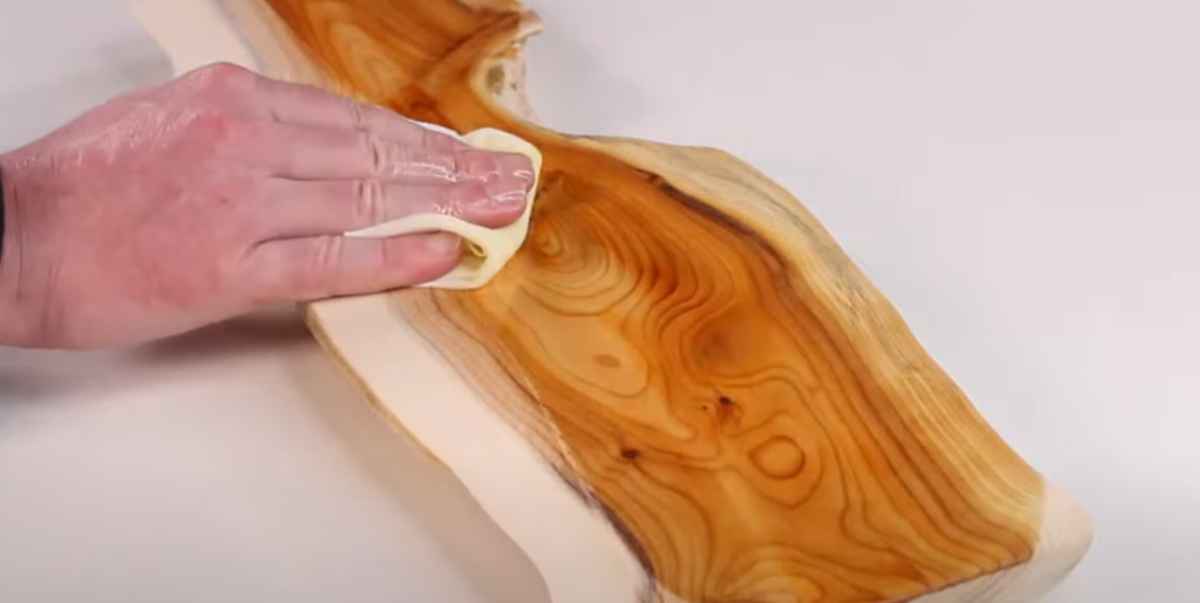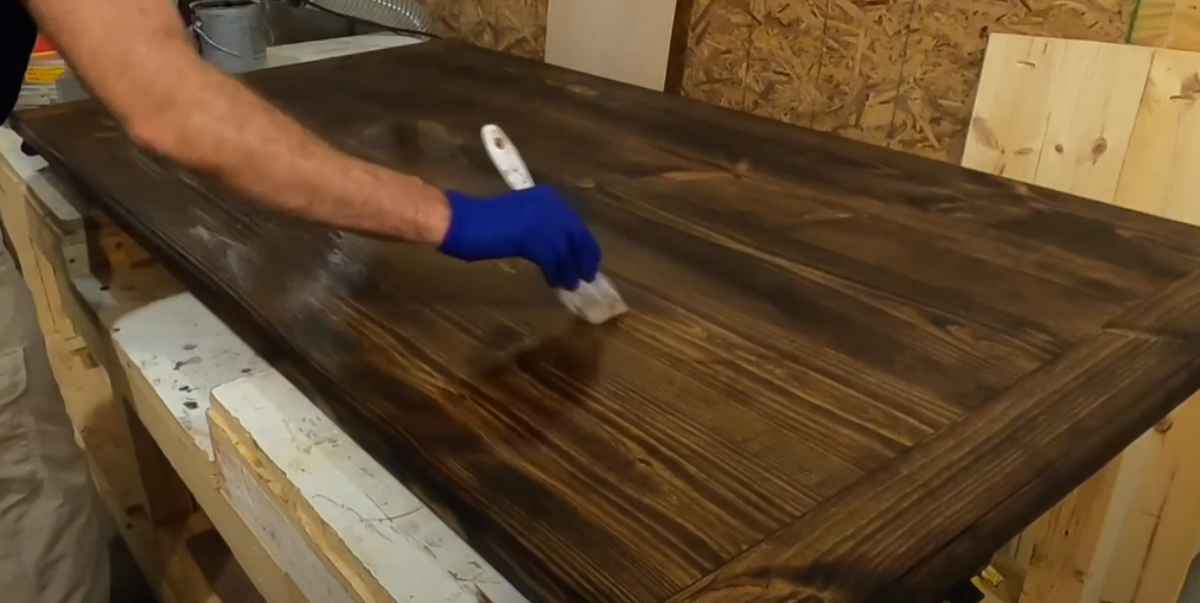To treat live edge wood, apply a sealant or finish to protect it from moisture and damage. Live edge wood can be treated by applying a sealant or finish to protect it from moisture and damage.
This will help to preserve the natural beauty of the wood and extend its lifespan. Additionally, regular cleaning and maintenance are essential to keep the wood looking its best. By following these simple steps, you can ensure that your live edge wood furniture or decor will last for years to come.
Now let’s dive into the details of how to treat live edge wood.
Choosing The Right Live Edge Wood
When it comes to treating live edge wood, one of the first steps is choosing the right type of wood. Understanding different wood types and evaluating their quality can help you make an informed decision. In this section, we will explore the factors to consider when choosing live edge wood, ensuring your project turns out beautifully.
Understanding Wood Types
Before you can select the perfect live edge wood for your project, it’s important to have a basic understanding of the different types of wood available. Each type has its distinct characteristics, such as color, grain pattern, and hardness.
Here are some popular wood types used for live edge projects:
1. Oak: Known for its durability and prominent grain pattern, oak is a popular choice for live edge furniture.
2. Walnut: With its rich, dark color and beautiful grain, walnut adds a touch of elegance to any live edge project.
3. Maple: Maple wood is highly regarded for its light color and smooth, even texture, making it perfect for a modern aesthetic.
4. Cherry: Cherry wood offers a warm, reddish-brown tone and a striking grain pattern that adds charm to any live edge piece.
5. Ash: Known for its excellent durability and light color, ash wood is often chosen for its versatility and strength.
Evaluating Wood Quality
Once you have identified the type of wood you prefer, it’s time to assess its quality. Evaluating wood quality ensures that you get the best piece for your project, ensuring longevity and appealing aesthetics.
Here are some factors to consider when evaluating the quality of live edge wood:
- Grain: Examine the grain pattern of the wood. A well-defined grain adds character and beauty to your project.
- Knots and Imperfections: Look for knots and imperfections in the wood. While small knots can add charm, large knots and defects can weaken the wood.
- Moisture Content: Check the moisture content of the wood. Optimal moisture levels prevent warping or cracking in the future.
- Cracks and Splits: Inspect the wood for any cracks or splits. Minor cracks can be repaired, but extensive damage may affect the structural integrity.
- Size and Thickness: Consider the size and thickness of the wood. Ensure it matches your project requirements and provides enough material to work with.
By carefully evaluating these aspects, you can select high-quality live edge wood that will yield exceptional results.

Preparing The Wood Surface
To treat live edge wood, start by preparing the wood surface. Begin by removing any rough patches and imperfections using sandpaper. Then, clean the surface thoroughly and apply a wood conditioner to help the wood absorb the finish evenly.
Removing Bark And Debris
Before embarking on your live edge wood project, it’s essential to prepare the wood surface properly. The first step in this process is removing the bark and debris from the wood. The bark not only detracts from the natural beauty of the live edge, but it can also harbor insects and fungus that can cause damage over time.
To remove the bark, you can start by using a stiff-bristle brush to scrub the surface gently. This action will help loosen any dirt, dust, or loose bark from the wood. Once the loose debris is removed, you can use a putty knife or a chisel to carefully scrape away the remaining bark. Be cautious not to gouge the wood or leave any marks behind.
After removing the bark, it’s important to thoroughly clean the wood surface to get rid of any lingering debris. You can use a damp cloth or a soft-bristle brush to wipe down the wood, ensuring that all traces of loose bark, dust, and dirt are removed. This step will provide a clean canvas for the next stage of the preparation process.
Sanding And Smoothing
Once the wood is free of bark and debris, the next step is to sand and smooth the surface. Sanding plays a crucial role in enhancing the natural beauty of the wood while also preparing it for any finishes or treatments you may want to apply later.
Start by using a medium-grit sandpaper to remove any rough patches or imperfections on the wood surface. Sand in the direction of the grain, applying even pressure to create a smooth and consistent finish. Gradually work your way to finer grit sandpaper for a more polished result.
Keep in mind that sanding can create a lot of dust, so it’s important to wear a dust mask and work in a well-ventilated area. To avoid overheating the wood, take breaks as necessary and periodically check the temperature of the sandpaper.
Once you’ve completed sanding, be sure to wipe away any residual dust using a tack cloth or a damp cloth. This will ensure a clean surface for the next steps, including applying finishes or protective coats.
Selecting The Right Finish
Discover the perfect finish for live edge wood with these essential tips. Enhance the natural beauty of your wood and protect it from wear and tear with the right treatment.
Exploring Different Finish Options
If you want to preserve the natural beauty of live edge wood while protecting it from wear and tear, selecting the right finish is crucial. There are various finish options available, each with its own advantages and considerations. Exploring the different finish options will help you make an informed decision based on your specific needs and preferences.
When choosing a finish for live edge wood, you can opt for traditional oil-based finishes such as tung oil, linseed oil, or Danish oil. These finishes penetrate the wood, enhancing its natural characteristics and creating a warm, rich color. Water-based finishes are another popular choice, offering quick drying times, low odor, and easy clean-up.
Varnishes provide a protective layer on the wood’s surface, offering excellent durability and resilience against scratches and moisture. On the other hand, wax finishes are known for their soft sheen and ability to create a smooth, silky feel. With various options to consider, it’s essential to weigh the benefits of each finish and how they align with your specific project.
Considerations For Indoor Vs. Outdoor Use
Whether you are treating live edge wood for indoor or outdoor use, the environment it will be exposed to plays a significant role in determining the appropriate finish. For indoor applications, factors such as exposure to sunlight, humidity levels, and foot traffic should be taken into account when choosing a finish. Considerations for outdoor use involve resistance to weather elements, UV protection, and overall durability to withstand the outdoor environment.
When treating live edge wood for outdoor use, marine-grade finishes or exterior-grade polyurethane can provide the necessary protection against moisture, UV rays, and harsh weather. On the other hand, for indoor projects, focus on finishes that offer resistance to stains, spills, and daily wear and tear. Understanding these distinctions will help you select a finish that best suits the intended application of the live edge wood.
Applying The Finish
When it comes to treating live edge wood, applying the right finish is crucial for a beautiful and long-lasting result. The finish not only enhances the natural beauty of the wood but also offers protection against moisture, stains, and everyday wear and tear. In this section, we will discuss the two essential steps in applying the finish: applying stain or oil and sealing and protecting the wood.
Applying Stain Or Oil
Before applying any stain or oil to the live edge wood, it is important to properly prepare the surface. Start by sanding the wood with a fine-grit sandpaper, going in the direction of the grain to achieve a smooth finish. Make sure to remove any dust or debris using a tack cloth or a soft brush.
Next, choose a stain or oil that complements the natural color of the wood and your desired aesthetic. Stains are perfect for adding depth and richness to the wood while still allowing the grain to shine through. Oils, on the other hand, penetrate the wood to nourish and enhance its natural beauty.
To apply the stain, use a brush, cloth, or sponge and work with the grain of the wood. Apply the stain evenly, making sure to cover the entire surface. For a deeper color, you can apply multiple coats, allowing each coat to dry completely before applying the next one.
If you prefer to use oil, simply pour a small amount onto a clean cloth and rub it onto the wood in the direction of the grain. Allow the oil to penetrate the wood for a few minutes, and then wipe off any excess with a clean cloth. Repeat this process if necessary.
Sealing And Protecting
Once the stain or oil has dried, it’s time to seal and protect the live edge wood. A durable finish will not only protect the wood from moisture and stains but also enhance its natural beauty and ensure longevity.
One popular option for sealing live edge wood is using a clear polyurethane sealer. This type of sealer creates a strong protective barrier on the wood surface, preventing moisture from seeping in and causing damage. Apply the sealer using a brush, roller, or sprayer, following the manufacturer’s instructions for the best results.
Another option for sealing and protecting live edge wood is using a natural wax. Applying wax helps to lock in the stain or oil, providing an added layer of protection and a beautiful sheen. Apply the wax using a soft cloth or brush, buffing it into the wood surface until it is evenly distributed.
Whether you choose a polyurethane sealer or a natural wax, make sure to apply multiple coats for optimal protection. Sand lightly between coats to create a smooth finish and remove any imperfections. Allow the final coat to dry completely before using or displaying your live edge wood piece.
Maintenance And Care
Proper maintenance and care of live edge wood are essential to preserve its natural beauty and extend its lifespan. By following a few simple steps, you can ensure that your live edge wood furniture or decor piece remains in excellent condition for years to come. In this section, we will explore two key aspects of maintenance and care: cleaning and dusting, and repairing damage.
Cleaning And Dusting
Regular cleaning and dusting are crucial in keeping your live edge wood looking its best. Here are some guidelines to follow:
- Dust the surface of the wood regularly using a soft cloth or a feather duster. This will help prevent the buildup of dirt and grime.
- Avoid using harsh chemicals or abrasive cleaners that can damage the wood’s natural finish. Instead, opt for a mild wood cleaner specifically designed for live edge wood.
- Gently wipe the wood surface with a damp cloth or sponge, taking care not to saturate the wood.
- Always dry the surface thoroughly after cleaning to prevent moisture from seeping into the wood grain.
- For stubborn stains or sticky residue, a mixture of mild dish soap and warm water can be used. Apply the solution sparingly and blot the area gently.
Repairing Damage
Accidents happen, and over time, your live edge wood may develop minor scratches, dents, or other imperfections. Here are some tips for repairing damage:
- For shallow scratches, carefully sand the affected area using fine-grit sandpaper in the direction of the wood grain. Follow up with a wood conditioner and apply a matching wood stain if needed.
- If the damage is deeper, consider using wood filler to fill in the gaps. After allowing the filler to dry, sand the area smooth and apply a protective finish.
- For small chips or dents, you can use a wax filler stick in a matching color. Apply the wax to the damaged area and buff it gently to blend with the surrounding wood.
- Regularly applying a high-quality wood polish or protective finish can help prevent future damage and keep your live edge wood looking its best.
By implementing these maintenance and care practices, you will be able to enjoy your beautiful live edge wood furniture or decor piece for years to come. Remember to consult the manufacturer’s guidelines if available and always test any cleaning or repair products on a small, inconspicuous area first.

Frequently Asked Questions On How To Treat Live Edge Wood
What Is The Best Coating For Live Edge Wood?
The best coating for live edge wood is a natural oil or a clear polyurethane finish. These options provide protection while enhancing the wood’s natural beauty. It’s important to choose a coating that suits your desired level of sheen and durability.
How Do You Preserve Live Edge Wood?
To preserve live edge wood, apply a sealant to the entire surface to protect it from moisture, use wax or oil to maintain the natural look and prevent cracking, and avoid exposure to direct sunlight to prevent fading and warping.
Regularly clean and polish the wood to retain its beauty.
Can You Seal Live Edge Wood?
Yes, you can seal live edge wood to protect it. Sealing helps to prevent moisture damage and bring out the natural beauty of the wood. Apply a clear, waterproof finish using a brush or spray. It’s important to sand the wood first for a smooth surface and follow the manufacturer’s instructions for best results.
How Do You Treat Live Edge Wood For Outdoor Use?
To treat live edge wood for outdoor use, follow these steps:
1. Begin by sanding the wood to smooth any rough edges.
2. Apply a waterproof sealer or finish, like polyurethane or epoxy, to protect against moisture and UV rays.
3. Reapply the sealer regularly to maintain the wood’s durability.
4. Use stainless steel or galvanized screws to prevent rusting.
5. Consider covering the wood during extreme weather conditions for added protection.
Conclusion
In order to preserve the natural beauty and longevity of live edge wood, it’s essential to implement the appropriate treatment methods. By choosing the right products and techniques, you can protect and enhance the wood’s unique characteristics. With regular maintenance, your live edge wood furniture will continue to be a stunning and functional addition to your space for years to come.


